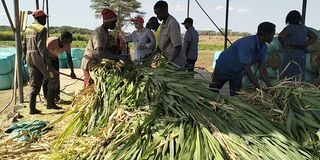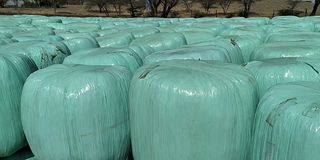Wonder grass reclaiming flood-prone and degraded land

Crushing and baling of harvested Juncao grass in Nayuu village in Turkana County.
What you need to know:
- Turkana County, a region historically plagued by destructive floods and devastating droughts—is witnessing a remarkable transformation, thanks to the introduction of Juncao grass, a Chinese-engineered hybrid grass.
Last April, heavy rains destroyed a critical borehole in Turkana County, disrupting water supply in six settlements in Lodwar Municipality.
Turkana County Urban Water and Sewerage Company PLC confirmed that Turkwel River burst its banks due to flooding and destroyed Borehole Nine, which supplies water to Juluk, Nabulon, Namariat, Kambi Mpya, Canan IDP and Hewani areas.

Baled Juncao grass ready for sale.
The borehole, located 30 metres from the banks of Turkwel River, was exposed as a result of soil erosion. Historically, the worst effects of flooding in the region are deaths and massive losses of property like in October 2019, when devastating floods from Turkwel River killed three people and hundreds of livestock.
But the narrative is changing.
Turkana County, a region historically plagued by destructive floods and devastating droughts—is witnessing a remarkable transformation, thanks to the introduction of Juncao grass, a Chinese-engineered hybrid grass. This innovative solution is reclaiming degraded land, stabilising flood-prone areas, and revolutionising livestock production in one of Kenya’s most arid and vulnerable regions.
Previously, Nayuu village near Lodwar faced severe soil erosion and flooding from Turkwel River. But not anymore.
Juncao grass, planted in 2024, has since stabilised the soil with its deep root system (penetrating 1.2 metres), preventing further erosion. The highly productive and drought-resistant grass has helped reclaim degraded land, transforming barren land into productive pasture.
The grass has reclaimed 50 acres of flood-prone land in the village.
Mr Jack Liu, the investor promoting Juncao, noted that the grass not only restores degraded land but also provides a valuable source of livestock feed, offering sustainable solutions for both agriculture and environmental conservation.
"I requested for land from locals to plant Juncao. They gave me a parcel that had experienced massive soil degradation from flooding rivers and surface runoff,” he said.
Juncao, a fast-growing, drought-tolerant grass is known for its strong, fibrous root system, high yield, and ability to thrive in various conditions, including low-fertility soils and arid regions.
“The roots have penetrated deeply into the soil, reaching depths of more than 1.2 metres. This has helped the plant to thrive even during the recent flooding because the soil has stabilised," Mr Liu said.
He explained that with support from locals who provided labour for initial plowing, he planted cuttings with two nodes each that have generated over 40 stems. He did not use fertiliser.
"We are expecting 180 tonnes of animal feeds annually from the one-acre farm that was initially sandy and without vegetation. It is now an oasis of fully grown green grass. This is a testament that the wonder grass can also combat desertification," Mr Liu said.
Mr Liu estimates that expanding cultivation could protect 1,000 acres across Turkana’s flood-prone regions.
The grass is also a wonder fodder crop that can boost both milk and meat production in Turkana County, which has the highest population of livestock in Kenya, because it has a crude protein content of around 18 per cent, significantly higher than traditional fodder options like Napier grass and maize.
"Compared to other types of grass that must be cleared and replanted annually, Juncao is perennial and can be harvested every two months for 30 years," Mr Liu said.
The grass was developed by Chinese scientists to address fodder scarcity, combat desertification and tackle perennial flooding in African countries.
It is offering pastoralists in Turkana an opportunity to venture into commercial fodder production with a ready market amid frequent droughts.
Cattle fed on Juncao mature in 18 months (compared to five–six years on natural grazing), reaching weights of 400 kg. Farmers like David Ekiru, who rears both indigenous livestock in Lodwar and dairy cattle in Eldoret, report doubled milk yields, from seven to 12 liters per cow daily.
The droughts
He is convinced that Juncao will change the lifestyle of Turkana pastoralists, especially in areas prone to recurrent cycles of droughts and flooding like Turkana West, which borders both Uganda and South Sudan.
"With support from the national government through the Ministry of East African Community, the county government and development partners, Juncao grass can be introduced on a large scale in Lopiding, Lotikipi, Lokangae Lokitela and Nasinyono villages, where residents migrate to neighbouring countries during drought or get displaced by floods during the rainy season," Mr Ekiru said.
Ms Elizabeth Lokolio, a Silo agrovet proprietor, said she is setting up a livestock feeds processing plant in Kakuma, where she is expecting to produce 10 to 20 tonnes of commercial feeds daily.
"Before being introduced to Juncao, I had targeted fodder leaves, pods and Cenchrus ciliaris grass species. I now want to partner with the Chinese investor for steady supplies to process pellets."


